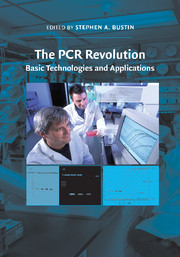Book contents
- Frontmatter
- Contents
- Contributors
- Foreword by Russell Higuchi
- Preface
- I BASIC TECHNOLOGIES
- 1 Real-time polymerase chain reaction
- 2 Thermostable enzymes used in polymerase chain reaction
- 3 Inventing molecular beacons
- 4 Rapid polymerase chain reaction and melting analysis
- 5 Polymerase chain reaction and fluorescence chemistries: deoxyribonucleic acid incarnate
- 6 Analysis of microribonucleic acid expression by quantitative real-time polymerase chain reaction
- 7 Miniaturized polymerase chain reaction for quantitative clinical diagnostics
- 8 The road from qualitative to quantitative assay: What is next?
- 9 Taking control of the polymerase chain reaction
- II APPLICATIONS
- Index
- Plate section
- References
3 - Inventing molecular beacons
Published online by Cambridge University Press: 25 January 2011
- Frontmatter
- Contents
- Contributors
- Foreword by Russell Higuchi
- Preface
- I BASIC TECHNOLOGIES
- 1 Real-time polymerase chain reaction
- 2 Thermostable enzymes used in polymerase chain reaction
- 3 Inventing molecular beacons
- 4 Rapid polymerase chain reaction and melting analysis
- 5 Polymerase chain reaction and fluorescence chemistries: deoxyribonucleic acid incarnate
- 6 Analysis of microribonucleic acid expression by quantitative real-time polymerase chain reaction
- 7 Miniaturized polymerase chain reaction for quantitative clinical diagnostics
- 8 The road from qualitative to quantitative assay: What is next?
- 9 Taking control of the polymerase chain reaction
- II APPLICATIONS
- Index
- Plate section
- References
Summary
The invention of molecular beacons followed a rather circuitous route. Our laboratory had been studying the remarkable mechanism of replication of the single-stranded genomic ribonucleic acid (RNA) of bacteriophage Qβ, a virus that infects Escherichia coli. When a few molecules of Qβ RNA are incubated in a test tube with the viral RNA-directed RNA polymerase, Qβ replicase, millions of copies of each Qβ RNA molecule are generated in only a few minutes by exponential amplification, without primers and without thermal cycling. Unfortunately, Qβ replicase is so specific for the particular sequences and structures present in Qβ RNA that it ignores almost all other nucleic acid molecules, disappointing scientists who would use its extraordinary amplification characteristics to generate large amounts of any desired RNA in vitro. However, our laboratory discovered that if a heterologous RNA sequence is inserted into an appropriate site within Midivariant RNA (MDV-1), which is a naturally occurring small RNA isolated from Qβ-infected E. coli that possesses the sequences and structures required for replication, the resulting “recombinant RNA” can be amplified exponentially by incubation with Qβ replicase. This discovery enabled the design of recombinant RNAs that contained inserted hybridization probe sequences, which were employed in the earliest real-time exponential amplification assays, and the use of which, paradoxically, led to the invention of molecular beacons.
Spurred by the emergence of the pernicious infectious agent human immunodeficiency virus (HIV)-1, which is present in as few as 1 in 100,000 peripheral blood mononuclear cells in infected asymptomatic individuals, we developed an assay that was designed to use the exponential amplification of recombinant RNA hybridization probes to measure the number of HIV-1 target molecules present in clinical samples.
- Type
- Chapter
- Information
- The PCR RevolutionBasic Technologies and Applications, pp. 19 - 47Publisher: Cambridge University PressPrint publication year: 2009



